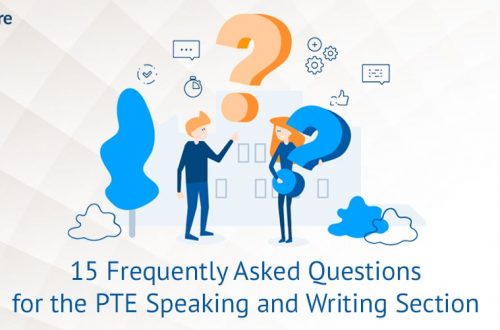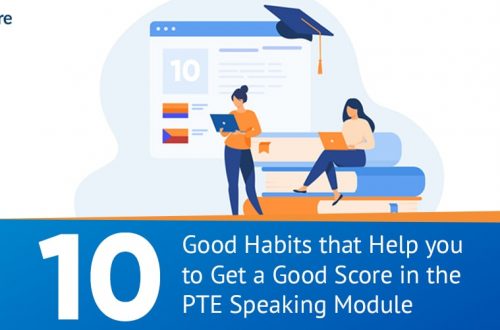The speaking section of the PTE Academic assesses the ‘fluency’ and ‘pronunciation’ of a test taker. It would not be wrong to call both of these important pillars of English as a language. It is not wrong to say that you can easily achieve perfect 90 scores in speaking if you are prepared with proper tricks for the exam. The speaking part also contributes to your score for listening as well, so you need to be well-prepared for the PTE Academic speaking section.
While it is not easy to master a language in a day, there are some techniques that one can use to crack this section. Please note that you can always develop your technique to tackle each question type according to your targeted score.
It is always better to do PTE Practice with a PTE score mock test and a PTE-scored practice test before actually jumping into preparation mode. Gauge your performance and highlight in which question you need to work out before actually preparing for it by giving the PTE score mock test.
PTE Academic Speaking Tips To Archive Target Score:
Below are PTE exam speaking tips that you must apply when preparing.
Read Aloud
-
Speak Naturally:
Imagine you’re explaining the sentence to a friend. Avoid sounding robotic. Add a conversational tone—this helps with fluency and intonation, and makes your speech easier to understand. -
Use Proper Intonation:
Stress important words (nouns, verbs, keywords). Rise and fall your tone naturally—rise slightly at commas (for continuation) and fall at full stops (to indicate ending). This shows good command of spoken English. -
Avoid Rushing:
Speak at a moderate pace—not too fast where words blur together, and not too slow where it sounds disjointed. A natural rhythm ensures both fluency and correct word stress. -
Practice Pronunciation:
Use tools or apps to record yourself. Compare your pronunciation to native speakers—pay attention to how sounds blend, stress patterns, and syllable emphasis. Repeat and adjust. -
Maximize Dual Scoring:
This task contributes to both Speaking and Reading scores. Reading fluently improves your speaking, and reading accurately supports your reading score. So, practice both clarity and accuracy.
Describe Image
-
Learn Vocabulary for Common Graphs:
Understand words and phrases to describe:-
Trends: increase, decrease, fluctuate
-
Comparisons: more than, less than, equal to
-
Distributions: spread, clustered, average
This helps you speak clearly about different image types (bar charts, maps, tables, etc.)
-
-
Structure Your Response:
Using a clear format helps organize your thoughts:-
Introduction: “The image shows a bar chart comparing…”
-
Body: Describe the main trends or key features.
-
Conclusion: Provide a general takeaway or observation.
-
-
Don’t Memorize Templates Blindly:
Templates are useful, but rigid ones sound unnatural. Use a flexible structure that adapts to different image types while allowing natural speech. -
Speak for the Full Time:
You should aim to speak for 35–40 seconds. Speaking too briefly shows weak content. Don’t pause too long or go silent—it affects your fluency score.
Re-Tell Lecture
-
Focus on Keywords:
While listening, write down:-
Main topics
-
Numbers/dates
-
Repeated phrases
These are usually the speaker’s key points.
-
-
Use Your Own Words:
Don’t try to memorize the lecture. Instead, use your notes to summarize in your own language, showing understanding and fluency. -
Structure Helps:
-
Intro: “The lecture was about climate change.”
-
Body: “The speaker mentioned rising temperatures and increased rainfall.”
-
Conclusion: “In conclusion, the lecture emphasized the urgent need for action.”
-
-
Practice Active Listening:
Train your ear to pick out relevant info quickly. Focus on who, what, when, where, why as you listen to lectures or podcasts.
Repeat Sentence
-
Listen Attentively:
You hear the sentence only once—so stay completely focused and avoid distractions. -
Shadow Practice:
Listen to native speech and repeat instantly, mimicking tone, rhythm, and speed. This boosts your memory and intonation. -
Train Your Memory:
Start by repeating short sentences accurately. Gradually practice with longer, complex sentences. This strengthens short-term memory. -
Avoid Pauses and Corrections:
Even if you forget a word, keep speaking. Fluency matters more than perfection. Don’t stop to correct yourself. -
This Task Is High-Weight:
It significantly affects both Speaking and Listening scores. So, it deserves more practice than lower-weight tasks.
Answer Short Question
-
-
Give Direct Answers:
Don’t repeat the question. If asked, “What is the capital of France?” just say “Paris”. No need to say “The capital of France is…” -
Build Vocabulary:
Questions often touch on general knowledge (science, math, daily life, culture). Learning basic terms helps you answer quickly and accurately. -
Stay Calm and Clear:
Even if you’re unsure, say your answer clearly. Hesitation affects your score. It’s better to guess with confidence than pause in silence. -
Practice with Flashcards:
Use Q&A flashcards or apps with audio. This helps build speed, vocabulary recall, and confidence under pressure.
-
Remember, achieving your target score in the PTE Academic speaking section becomes much easier when equipped with the right strategies and consistent practice. Make sure to apply these techniques during your mock test sessions.
Gurully’s PTE platform is a great place to practice effectively. It offers full-length mock tests, section-wise assessments, and free question-wise practice. With instant, AI-powered accurate scoring, you can track your performance in real-time and make focused improvements to reach your desired score.
Conclusion:
- Also Read:
- Practice With Most Repeated PTE Speaking Read Aloud Examples
- PTE Core Test Booking 2025 | Book PTE Core in Canada
- Know the Top 7 Free Website for PTE Practice & Be Exam Ready
|
79Score
|






